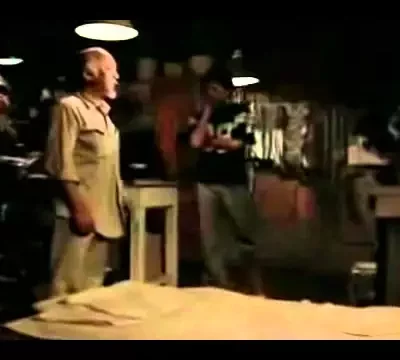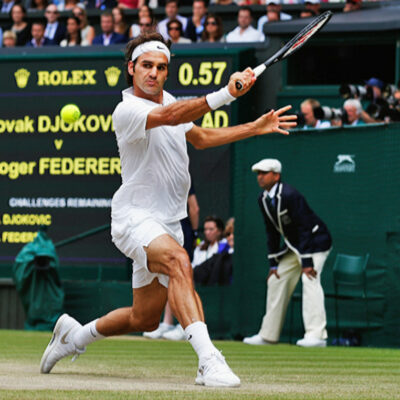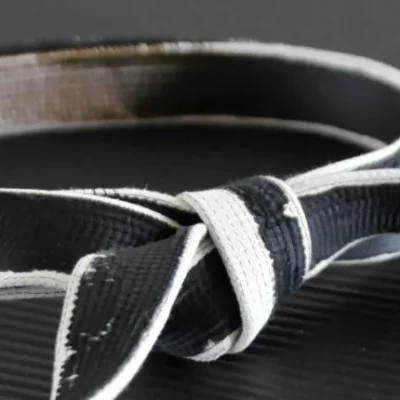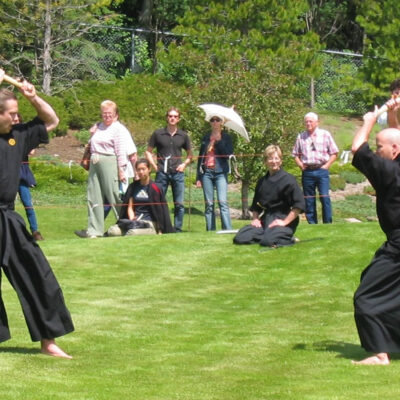For many of us interested in Martial Arts, part of the allure is belonging to an exclusive group. Martial Artists hone their body and mind through physical challenge and dedication. It builds confidence in ourselves. It sets us apart. It makes us unique.
However, there are those who wish to utilize the mystique of a martial art for personal gain. They promise to provide the essential elements of martial arts training as a lure to draw in well-intentioned, but naive, students. In reality they are interested in only feeding their pockets and their ego.
I’m of course talking about the McDojo.
“McDojo” is typically a derogatory term for a martial arts school that prioritizes marketing and revenue over substance of training. It draws a parallel between the quality of food at McDonalds with the quality of training. Instead of being handcrafted it’s made on an assembly line.
However, comparing the training at a McDojo to the food at McDonald’s isn’t a perfect analogy. When we eat food at McDonald’s, we understand what we’re getting: consistent fast food. Often, we’re happy to eat this as it satisfies what we desire and fulfills our expectation. On the other hand, a McDojo often misrepresents itself in attempt to prey upon the naivety of those who don’t have martial art experience.
Primarily the model of a McDojo comes from Taekwondo school chains. While Taekwondo itself is a legitimate art – and one of the most widely practiced arts in the world – many business and marketing systems were developed to focus on acquiring students and getting as much money from them as possible.
The model is in part adopted from the concepts behind fitness gyms. Gyms sell memberships with the understanding that most people will sign-up and then fail to show up. Those that pay for a membership, but don’t utilize the facility, subsidize the members that attend. Eventually those not attending will cancel, and that revenue will need to be replaced by new people who sign up (known as churn). The focus in this model is then on maximizing short term value of the member, and acquiring new members.
Martial Arts Studios – in particular Taekwondo chains – adopted elements of this model. Most students eventually stop training for a variety of reasons. The goal of a McDojo is to extract as much value from a member before they quit. This usually involves pre-paying for memberships, rank promotions, and/or equipment.
Essentially, the school becomes a shark that dies if it stops swimming. The focus of the entire organization becomes acquiring new students. In order to do this, often the curriculum is made easier and more palatable to a wider audience to increase new enrollments. This decreases the learning curve at the expense of depth and challenge of training. This is what is meant when training is said to be “watered-down”.
For the most part, the McDojo model is adopted because it is easy and is effective in the short term. Attracting a following of committed and dedicated practitioners is time consuming, expensive and challenging. If a school owner relies on teaching as their primary income, and doesn’t have the resources to invest in the long-term, it can create a desperate situation where revenue is needed quickly.
Many schools don’t become a McDojo overnight. Rather, it is a slow process of compromising training for revenue in order to attract new students. Often marketing puffery increases to attract new students while the quality of training decreases. Students eventually are seen as money to be extracted before they become bored or disenchanted with training.
The McDojo will eventually hit a peak before slowly declining once they have exhausted the market of new students and negative word of mouth spreads. The decline then accelerates as the majority of training students become prepaid as a quick fix. Enrollment drops, churn increases, and cash flow dwindles. Eventually the school dies. And all money paid into the school is lost.
If someone hasn’t had experience in Martial Arts training, it can be difficult to discern a quality martial arts school from a McDojo. Context is key. Here we will provide some “red flags” of a McDojo. We will also juxtapose these red flags against our school policies that protects our students.
One of these red flags alone does not constitute a McDojo. However, the more red flags you identify, the more likely the school is more interested in money than providing quality training.
Here are some warning signs of a McDojo:
This is where the term McDojo first originated, as well as the term “Belt Factory”. Students are forced in short periods of time to test for a belt rank and then charged heavily for it.
To obtain an official license from an organization, there is often a charge for certification. However, some schools may opt to charge for the belt itself, the time to administer testing (even if it takes place in a regularly scheduled class), a certificate printed on a printer that is only valid within the school, or all of the above.
This offers great profit potential, and creates a monetary incentive to promote more people faster to bring in revenue.
If you feel you are being pushed into a rank, or are being given it for disingenuous reasons, you can politely decline rank and see how the teacher reacts. Fun fact: this is considered polite in Japanese Martial Arts since it demonstrates humility.
How we combat this: We don’t have any belt or testing fees. We only charge for an official license from Japan when a student opts to purchase it. Typically we recommend this for Dan ranks or if a student is moving and wants to continue training the art at another school.
High pressure selling tactics is one of the earliest signs of a McDojo.
While you should be expected that a school will ask you to make a decision, and they will likely attempt to persuade you to join their school, you shouldn’t feel intimidated to say no or at least ask for more time to make a decision.
A school should be focused finding what is a best fit for both the school and for the potential student. If they seem indifferent to your concerns and only want you to sign the bottom line, it’s a strong indicator that they only value you for your money and might not have your best interests at heart.
How we combat this: Our main goal for any potential student is to have them try a class. If the person likes it, we’ll recommend a membership. If they didn’t, or are looking for something different, we’ll recommend another school that might be a better fit. The goal is always to have someone make an informed decision for themselves. We often recommended other schools and arts depending on what someone is looking for.
Contracts are a necessity for any school. A waiver or release of liability is often the first contract you sign.
However, long-term contracts that extend up to several years or – worse – to a specific rank, can be a warning sign. They are often used to guarantee income while a student is not training or decides to quit.
Most important of any contract are the specific terms of the contract and how easily a student can be released from their training. You can read more about this in our blog post on Martial Arts Contracts.
How we combat this: All our memberships are month-to-month. Students can pause memberships as they see fit, no explanation required. The only exception is if a student wishes to prepay for a year to obtain a discount.
Schools will often offer prepaying a membership for a discount. Students might like not having to pay monthly, and enjoy getting training for less. If you have means, and it makes sense, why not?
Yet, prepaying beyond a year can be an issue for both the student and the school.
For the student, it’s a gamble on predicting their future. Life is unpredictable, and it can be difficult to foresee challenges you may face in two to three years. You may lose your job. You might have to move. Etc. Often you can’t get a refund on the unused portion of your prepaid membership.
For the school, this means that they no longer have a steady stream of revenue to cover fixed overhead costs such as rent. If that money isn’t managed well, the school might suffer a cash flow shortage leading to increased emphasis on acquiring new students and neglecting the current student body. If enough students prepay, and there is insufficient new students coming in, the school will eventually go out of business.
How we combat this: We limit prepaying to one year for a discount, and limit the number of students we allow to prepay.
Equipment sales, often referred to as the “Pro Shop sales”, presents another profit center for a martial arts school. Training tools, such as practice weapons, are essential to learning certain types of martial arts.
However, some schools sell equipment to new students that is rarely used – often bundled into a package. A student buys the equipment in good faith assuming it’s something they need for class. Then a year later, there are items that still haven’t been utilized.
An even greater warning sign is when items cannot be purchased individually on an as needed basis, or students are pressured into buying the package all together.
How we combat this: We offer all training weapons and tools free of charge. Students can invest in their own tools for training, but are not required to do so.
In most businesses, some customers subsidize other customers. Good businesses match the perceived value with an appropriate price for difference customers.
In a martial arts school, there are practitioners which place a higher value on training than others and are willing to pay more for it. For example, those that value training more are likely to attend more classes. Or maybe a student wishes to have more in depth training on a subject. In either case, a student is likely to pay more for this opportunity. Being able to match student cost to value perceived is good for both students and the school.
However, in the case of a McDojo, upgrades are used to fulfill the original promise of training. A school will make a promise of a certain level of training for a specific membership, not fulfill it to the level of value promised, and instead push an upgraded membership to give the value originally promised to the student. The “real” training the student is looking for remains elusive behind yet another upgrade. The art becomes completely fractured amongst many levels of upgrades without clear understanding of how each membership fits into training.
How we combat this: We base all memberships on frequency and duration of training. If you want to train more and upgrade, you’ll a pay a little more. This keeps things simple and transparent while ensuring students pay the appropriate amount for real value.
Truth be told, anyone can open a martial arts school and proclaim themselves a teacher. Even more troubling, anyone can “invent” their own art and elect themselves as the “grandmaster”.
This has to do with ego as much as making money. The more grandiose a teacher’s claim, the more weary a potential student should be.
A powerful example of this is Frank Dux. After likely training for a few years in a couple of Japanese martial arts, he proclaimed himself the lineage holder of a mysterious line of Ninjutsu – and renamed it Dux Ryu. He also said he was essentially an assassin for the CIA, and participated in a super secret tournament to the death (called Kumite, which ironically is the word for sparring in Karate) that he won many years running. If this story sounds familiar, it’s the plot of “Bloodsport” that was based in part on Dux’s claims.
All of this has been thoroughly debunked.
We could say that his dojo was McDojo for the fact that it totally misrepresented what was being taught as a means to acquire money and fame. It doesn’t mean there was zero value to what was being taught, only that it was taught dishonestly.
Other examples would include the Black Dragon Society, Ashida Kim, No Touch Knockout Teachers, etc. These schools are dangerous to students because the training is not really based on anything meaningful and only exist to serve the teacher’s ego.
How we combat this: I always acknowledge my mistakes and doubts to our students. I know I don’t have all the answers, and encourage our students to meet other instructors of both our art and other arts to gain perspective. I also test things in class to make sure that what is being taught aligns with the promise made of our training. I try to remain humble, and remain a student of our art.
Final Thoughts
The “McDojo” is really in the eye of the beholder. It’s a relative term.
In the end all that matters is that you’re getting what you feel is the appropriate value for what you pay. In truth, there is no perfect martial art, dojo, or teacher. Rather martial arts training is a personal journey.
Expect it to be a challenge. Go into it with open eyes. Keep things in perspective. Follow your instincts.
And most importantly, keep going.






